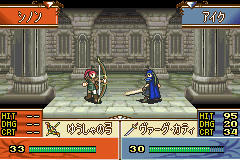


Get well acquainted with saving and loading, since you’ll be using it a lot if you hope to make it through alive. Even your strongest units can fall fast against certain enemies. Not only can characters die, but sometimes they can die quite easily. As a result, this game requires more actual strategy than most strategy RPGs. This makes you want to be extra careful with every unit, and planning ahead to prevent possible deaths. Another change from other strategy RPGs is that once a character is defeated in battle, he/she dies for good. i.e.: sword beats axe, axe beats lance, lance beats sword. The most important difference from other strategy RPGs is that Fire Emblem utilizes a weapon triangle system. Even still, the graphics are quite well done.Īnyone who’s played any of the Fire Emblems, or even other strategy RPGs in general, shouldn’t have too much trouble figuring out how to play this. Visually, there’s not much difference between FE6, and the later GBA games. Melee, and became pretty popular in that. This game is a DIRECT SEQUEL to Fire Emblem 7, plus FE6’s main character Roy appeared in Super Smash Bros. And, of all of them, the one i’m most puzzled about not being localized is this game: Fire Emblem 6.

So, as a result, we’ve still been missing out on the first 6 games. Of course, eventually Nintendo DID catch on that the series should come out here, but only after Fire Emblem 7 (Just plain Fire Emblem in the U.S.) was released. So, why exactly did the series never come out here? Nobody is quite sure, although strategy RPGs definitely had a dedicated audience. The strategy RPG genre was more or less pioneered by Fire Emblem, and refined by Shining Force. Fire Emblem was always one of those innovative series that made you scratch your head trying to figure out why it never made it to the West, especially when numerous titles influenced by it were flooding the market here.


 0 kommentar(er)
0 kommentar(er)
